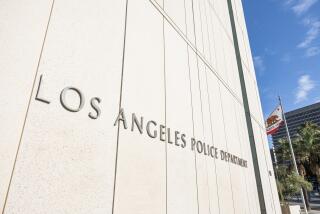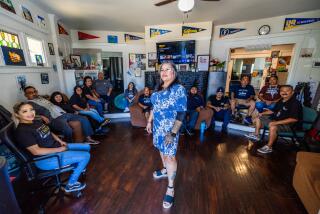U.S. Lawmen Plot Strategy Against Spread of L.A. Gangs
- Share via
KANSAS CITY, Mo. — In Oklahoma City, Detective Charles McIntyre has taken to storing a Los Angeles city street map in the top drawer of his desk. The often-used map, he said, is an important investigative tool for determining the neighborhood ties and gang affiliations of the 30 Los Angeles black street gang members caught peddling cocaine in his city in the last year.
In Sacramento, police who two years ago were urgently contacting Los Angeles authorities for intelligence about Bloods and Crips are in turn being contacted by other cities. Sgt. David Poroli said it appears that some Sacramento youths who learned the drug-selling trade from invading Los Angeles gang members are themselves hitting the road.
In Portland, Ore., upward of 400 local youths have been recruited by more than 100 Los Angeles street gang members who have moved there in the last two years to sell crack, Officer Neil Crannell said. In May, nine gang-related drive-by shootings took place within five days.
Strategies Being Developed
Alarmed by the increasing mobility and spiraling drug sales by Los Angeles street gang members--as well as the violence they spread--more than 50 lawmen from 11 Midwest and Western cities gathered here Thursday to develop national strategies to deal with the gang-dope trafficking menace.
The two-day forum sponsored by the FBI and the Kansas City Police Department is part of an attempt to slow the growth of the Los Angeles traffickers. Some police officials fear that the gangs will develop “a real solid structure, such as happened with the Cosa Nostra and other organized crime groups,” said Frank J. Storey, special agent in charge of the Kansas City FBI office.
Right now authorities agree that the gangs do not qualify as organized criminal enterprises.
“You don’t have street gangs organized in drug trafficking as such,” said Los Angeles County Dist. Atty. Ira Reiner, who is attending the conference. “Rather, you have street gang members (with access to large quantities of drugs) who call on fellow members to help them.”
Generally, the gang members set up shop “in cities where they have relatives and friends,” Crannell said.
Over time, however, the numbers have added up. In the last two years, authorities say, hundreds of members of Blood and Crip factions, operating in small packs, have helped establish out-of-town drug-selling operations. After intimidating local drug merchants, the gang members have taken advantage of the higher prices they can command in cities where the drug supply is small and the competition weaker than at home.
In all, Los Angeles Police Cmdr. Lorne Kramer said, members of 25 Los Angeles street gang “sets” or factions have been reported dealing drugs in more than 45 cities across the nation.
“There’s some very fertile ground out there,” declared Kramer, who addressed the conference. “We’ve even heard of (rival) Bloods and Crips forming alliances out of town for the profit motive.”
While inquiries were received from many of the affected cities, attendance at the conference has been limited mainly to those with the most intense gang infiltration. On the list are Seattle, Las Vegas, Minneapolis, Omaha, Kansas City, St. Louis and Denver, as well as Portland, Oklahoma City and Sacramento.
In the first session, closed to the press, presentations were made by officials from each city, highlighting their problems and methods of combatting them.
This morning, specific national strategies are to be discussed. One idea under consideration, Storey said, is the development of a national computerized data bank to keep track of the movements of gang-related drug sellers.
FBI Not Ready to Commit Manpower
Storey and national FBI officials emphasized that the FBI is not yet prepared to commit large-scale federal manpower to fighting street gang drug trafficking.
“We’re trying to get a handle on the scope of the problem so we can make a decision as to where and how we can best address these groups . . . in terms of our national drug strategy,” said Thomas Fitzpatrick, a supervisor in the FBI’s drug section in Washington.
But conference participants appear to agree that the more help the better.
Crannell, like many, said a common approach makes sense because the same groups are hitting many of the same cities in the same way. As well, some large-scale Los Angeles drug sellers operate crack houses in several other cities.
In one recent case, a member of the Nine-Deuce Hoover Crips was convicted of offenses stemming from his operation of crack houses in Seattle and Oklahoma City.
Kansas City Police Chief Larry J. Joiner said that in his city, there is very little visible evidence of gang activity. Indeed, Joiner can quickly recite the locations of all three walls in the city where he said gang graffiti appear.
Nonetheless, Joiner added, at least 30 Los Angeles gang members are operating drug houses. And in the last four months, eight federal indictments have been filed here against Los Angeles street gang members.
More to Read
Sign up for Essential California
The most important California stories and recommendations in your inbox every morning.
You may occasionally receive promotional content from the Los Angeles Times.










